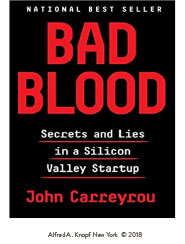Medical science has made tremendous strides over the past 100 years. New vaccines and antibiotics together with our understanding of the need for clean water and better food have helped global life expectancy levels more than double. And as Eric points out on page 2, the outlook for further progress is bright. But from an investor standpoint, it is important to understand two points. First, true medical breakthroughs are difficult to predict. Second, making money on such innovations is a separate and distinct task from identifying innovative companies.

Nothing brings these points home more clearly than the story laid out in John Carreyrou’s book Bad Blood: Secrets and Lies in a Silicon Valley Startup. The book, which reads like a crime novel, covers the rise and fall of multibillion dollar biotech start-up Theranos. Bad Blood hit The New York Times’ Best Seller list in 2018, but is back in the news thanks to the current trial of founder Elizabeth Holmes for corporate fraud. I listened to the audio version of the book on a recent long drive and walked away with a few cautionary reminders of how to approach investing in the biotech or, in fact, any new technology sector.
Watch out for charismatic leaders:
Elizabeth Holmes displays many of the characteristics of a charismatic leader; confidence, determination, intelligence, and vision. For evidence of this, consider that by the age of 20 she had succeeded in raising almost $7 million in start-up funds for her blood testing venture despite having completed only one year of college and no experience running a business. The lesson here? Charismatic leaders may have an easy time raising capital, but that trait can also obscure other more concerning characteristics. It will be interesting to see how her charisma plays to the jury now.
Beware of FOMO (Fear of Missing Out):
Elizabeth Holmes’ charisma and the appeal of being a part of the next “big thing” drew several highly respected individuals to the Theranos board. Such early supporters included former Secretaries of State George Schultz and Henry Kissinger and Marine Corps General Jim Mattis. Their imprimatur then helped convince a range of family offices, individuals, and venture capital funds to invest. In total, Theranos reportedly raised roughly $724 million of capital despite having made not one dollar of profits. Interestingly, a careful reading of the investor list would have revealed that few, if any, biotech focused funds or R&D arms of the big pharma companies (i.e., the “smart” money) opted to invest in Theranos.
If it seems too good to be true, it probably is:
Several highly respected scientists focusing on blood testing were skeptical that Theranos could meet its claim to successfully run up to 800 blood tests on a single drop of blood and deliver those results in less than 30 minutes. The scientific challenge which required quick and accurate results from diluted blood samples, they claimed, was simply too great. While it is important to not rule out the possibility and, even likelihood, of medical breakthroughs, this case is a reminder to pay particular attention to the unbiased experts in the room.
Examine employee turnover:
Investors almost always lack all the information they need to make decisions. This was particularly true in Theranos’ case where Elizabeth Holmes helped create an environment of fear and intimidation which prevented most employees from speaking out. But even with these obstacles in place, the frequent turnover among key employees (a metric more easily discovered) should have served as a warning sign to investors.
Investing can be a humbling endeavor and with that in mind, it is important to remember how little we know or can know about the firms we invest in. But there are a few simple steps investors can take to control risk: Diversify your portfolio across individual holdings, sectors, and asset classes. Tailor your risk exposure to your tolerance for risk, and don’t invest in things you don’t understand. In cases like biotech, which can be difficult to understand, a commingled or fund approach often makes most sense.